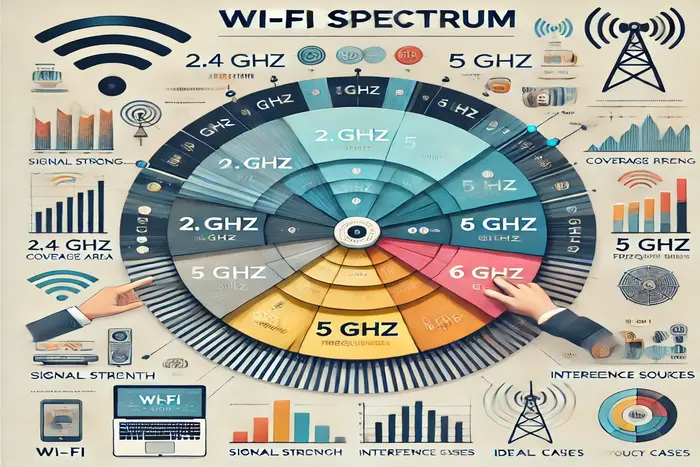What is Wi-Fi Spectrum
March 24, 2025

Understanding Wi-Fi Spectrum and Its Importance
Wireless connectivity has become an essential part of our daily lives, and ensuring stable internet performance depends heavily on the Wi-Fi spectrum. Grasping the concept of Wi-Fi spectrum is crucial for creating a reliable wireless network, whether at home or in a commercial environment. By understanding the frequency bands, channel widths, and interference factors, users can improve their internet experience significantly.
Exploring the Wi-Fi Spectrum
The Wi-Fi spectrum refers to the range of frequencies through which Wi-Fi signals are transmitted. These frequencies enable wireless devices to connect to the internet without physical cables. To build an efficient network, understanding the key elements of the Wi-Fi spectrum is essential.
Frequency Bands and Their Roles
Wi-Fi signals primarily operate in two key frequency bands: 2.4 GHz and 5 GHz. Each plays a distinct role in determining the speed, range, and stability of the connection.
The 2.4 GHz band is widely used due to its longer range and ability to penetrate walls and obstacles effectively. It is ideal for covering larger spaces, making it suitable for homes, offices, or other environments requiring broad coverage. However, this frequency band often faces congestion as many household devices, including microwaves and cordless phones, also operate in this range.
On the other hand, the 5 GHz band offers faster data speeds with reduced congestion. This frequency band is best suited for crowded areas where multiple networks and devices are active. Although the range is shorter compared to 2.4 GHz, it provides superior performance for tasks like video streaming, gaming, and high-speed downloads.
Channel Width and Data Flow
Wi-Fi channels function similarly to lanes on a highway. These channels determine the amount of data that can flow through the network at any given time. Wider channels allow more data to pass through efficiently, improving performance. However, wider channels are more susceptible to interference from neighboring networks.
Selecting the appropriate channel width is crucial in ensuring optimal performance. For environments with multiple Wi-Fi networks, reducing channel width can minimize congestion and maintain stable connections. Conversely, in low-traffic areas, a broader channel width can enhance speed and overall performance.
Minimizing Interference for Better Performance
Interference is a common challenge that affects Wi-Fi performance. Factors such as overlapping networks, microwaves, Bluetooth devices, and cordless phones can significantly reduce signal quality.
To mitigate interference, consider positioning your router away from electronic devices that emit similar frequencies. Additionally, selecting the least congested Wi-Fi channel can improve connectivity. Advanced routers are equipped with auto-channel selection features that automatically detect and switch to the most stable channel for enhanced performance.
The Role of Dual-Band Routers
Modern routers often come with dual-band functionality, allowing them to operate simultaneously on both the 2.4 GHz and 5 GHz bands. This feature is highly beneficial for maximizing coverage and speed.
For instance, connecting devices that require fast internet speeds, such as gaming consoles or smart TVs, to the 5 GHz band can improve performance. Meanwhile, devices that demand extensive range, such as security cameras or smart home gadgets, perform better on the 2.4 GHz band. Leveraging dual-band routers helps balance network traffic and improves connectivity throughout the premises.
Understanding Wi-Fi Standards
Wi-Fi standards are established by the Wi-Fi Alliance to ensure compatibility and performance across wireless devices. The latest standard, Wi-Fi 6, introduces notable improvements in speed, efficiency, and reliability.
Wi-Fi 6 devices are designed to handle multiple connections more effectively, reducing latency and improving overall network capacity. Investing in routers and devices that support this standard ensures better performance and future-proofs your network for evolving technology needs.
The Importance of Wi-Fi Spectrum for Internet Performance
The Wi-Fi spectrum plays a critical role in defining internet performance, particularly when it comes to stability and speed. Providers such as Asianet Fiber, recognized as one of the best internet providers in Kerala, utilize advanced Wi-Fi spectrum technologies to deliver consistent high-speed internet to users.
Without a clear understanding of the Wi-Fi spectrum, users may face frequent connectivity issues, such as slow internet speeds, dropped signals, or unreliable performance. By learning about frequency bands, channel widths, and interference reduction techniques, users can optimize their wireless network for improved results.
Optimizing Your Network with the Right Provider
To experience seamless connectivity, choosing a reliable internet provider in Kerala is essential. Asianet Fiber offers high-speed internet solutions that leverage efficient Wi-Fi spectrum management, ensuring users enjoy stable connectivity for their digital needs.
Whether streaming content, participating in video calls, or managing smart home devices, a well-optimized Wi-Fi spectrum can significantly enhance performance. By ensuring the right router settings, minimizing interference, and utilizing modern devices that support Wi-Fi 6, users can unlock the full potential of their internet connection.
Understanding the Wi-Fi spectrum is crucial for maintaining a fast and stable internet connection. By exploring the frequency bands, channel width settings, and modern standards, users can build a network that effectively meets their digital demands. Choosing a trusted provider like Asianet Fiber enhances connectivity by ensuring the network is optimized for maximum efficiency. Investing in a proper understanding of the Wi-Fi spectrum is key to ensuring smooth performance and uninterrupted access to high-speed internet services.

